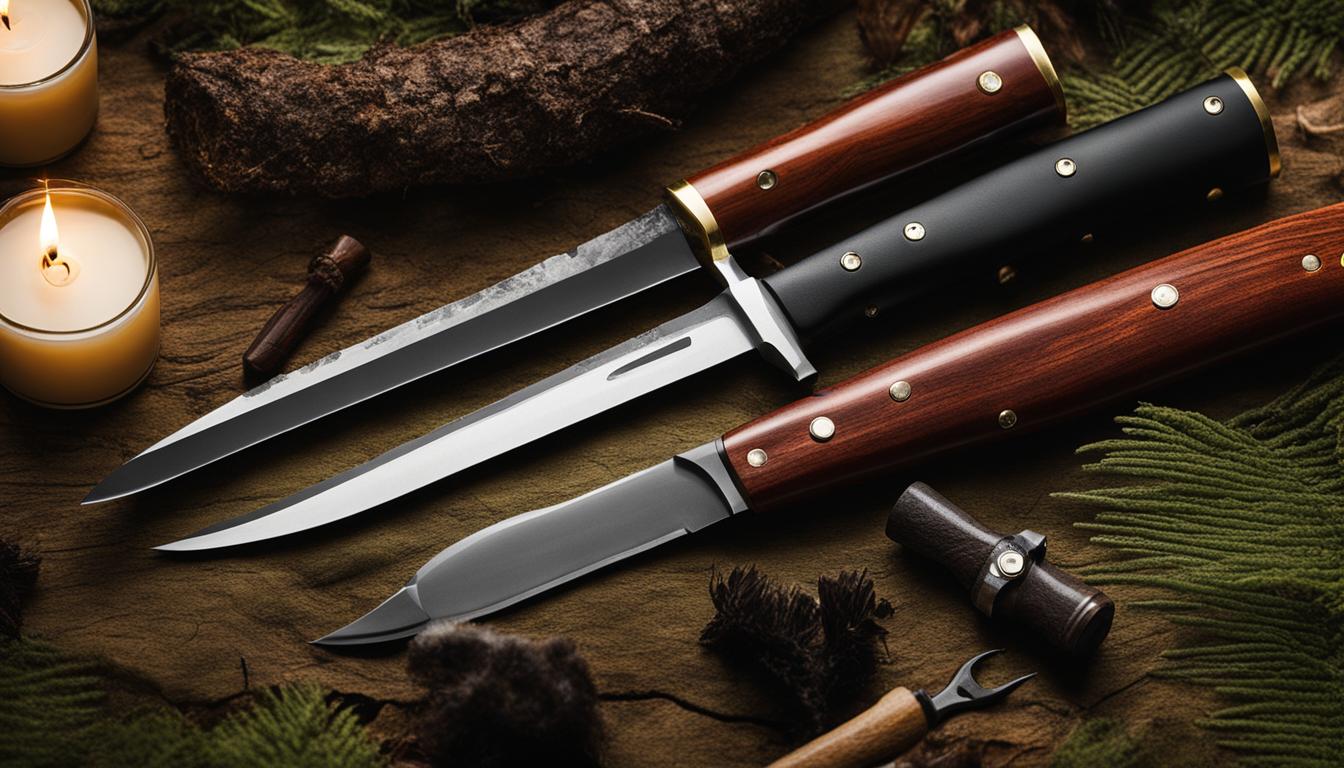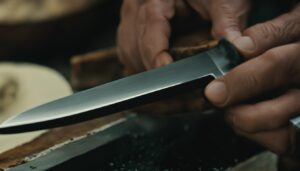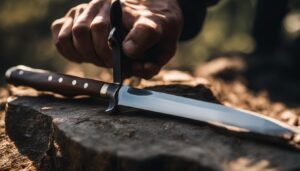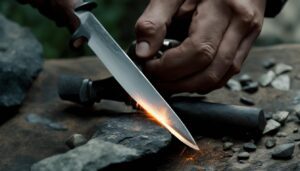Properly maintaining your hunting knife is crucial for its longevity and your safety. Follow these five essential tips to ensure your knife stays sharp, rust-free, and ready for your next adventure.
Key Takeaways:
- Regularly sharpen your hunting knife using the appropriate method and angle.
- Properly clean your knife to remove debris and prevent rust formation.
- Ensure your knife is dry before storing and apply oil to prevent corrosion.
- Inspect your knife regularly for any maintenance issues and address them promptly.
- Reach out to the manufacturer’s Customer Service for assistance with repairs or replacements.
Keep Your Knife Sharp
Properly maintaining the sharpness of your hunting knife is essential for optimal performance in the field. To keep your knife sharp, you’ll want to use a fine ceramic rod or fine-grit stone to touch up the blade regularly. It’s important to address dullness before it becomes too severe, as a sharp knife is safer and more efficient to use.
The sharpening method you choose should be based on the purpose of the blade and the correct edge angle. Different types of knives, such as hunting knives, pocket knives, and kitchen knives, may have varying recommended edge angles. So, be sure to consult the manufacturer’s guidelines or sharpening resources to determine the appropriate angle for your specific knife.
When sharpening your hunting knife, select the appropriate abrasive grit based on the condition of the blade edge. Coarser grits are used for reprofiling or shaping, while finer grits are used for general sharpening. After sharpening, finish the process by stropping the blade on a leather strop. This helps to refine and polish the edge, ensuring a razor-sharp finish. Remember to maintain proper technique and take your time to achieve the desired results.
Maintaining a Hunting Knife: Key Points
- Regularly touch up the blade using a fine ceramic rod or fine-grit stone.
- Choose the appropriate sharpening method and edge angle for your specific knife.
- Use different abrasive grits for reprofiling and general sharpening.
- Finish the sharpening process by stropping the blade on a leather strop.
“A sharp knife is a safe knife.” – Unknown
Keep Your Knife Clean
Properly cleaning your hunting knife is essential for maintaining its performance and preventing rust. By following these proper knife cleaning techniques, you can ensure that your knife is always in top condition.
Routine Cleaning
Start by wiping down the blade with a lint-free cloth or paper towel to remove any dirt or debris. If the blade has tougher grime or abrasive material, you can rinse it under water before wiping. Be sure to dry the knife thoroughly after cleaning to prevent moisture from causing rust.
For a more thorough cleaning, use a mild cleaning agent like dish soap. Apply a small amount of soap to a damp cloth and gently scrub the blade. Once clean, rinse the blade with water and dry it completely. Make sure to clean inside the handle and around the blade pivot using a soft-bristle toothbrush, cotton swabs, toothpicks, or compressed air. This will remove any dirt or buildup that can affect the knife’s performance.
Tackling Stubborn Spots
If you encounter stubborn spots like tree sap or tape residue on your hunting knife, rubbing alcohol can be effective. Dampen a cloth with rubbing alcohol and gently rub the affected area. Rinse the knife with water and dry it thoroughly afterwards. It’s important to note that rubbing alcohol should be used sparingly and promptly rinsed off to prevent damage to the knife’s materials.
Remember, keeping your hunting knife clean is not only important for its performance but also for your safety. By incorporating proper knife cleaning techniques into your maintenance routine, you can ensure that your knife is always ready for your next outdoor adventure.
Keep Your Knife Dry and Well-Oiled
When it comes to preventing rust on your hunting knife, keeping it dry is paramount. Moisture is the main culprit behind rust formation, so always make sure to thoroughly dry your knife before storing it. This is especially important if you have a fixed blade knife stored in a leather sheath, as moisture can easily become trapped and cause corrosion.
In addition to keeping your knife dry, applying oil is another effective way to prevent rust. By lubricating the pivot and other moving parts of the knife with a small amount of oil, you can create a protective barrier that inhibits rust formation. Choose a suitable lubricant for your knife, such as a petroleum-based oil or a food-safe option if you plan on using the knife for food preparation. It’s important to note that wet lubricants may attract debris, so if you’re concerned about this, you can try using dry Teflon-based lubricants instead.
It’s also worth mentioning that different handle materials may require specific treatments to prevent rust. For example, wooden handles can benefit from the application of clinch oil, while leather sheaths can be treated with coconut oil. These treatments help keep the materials well-maintained and protected from moisture, ensuring the overall longevity of your hunting knife.
By keeping your knife dry and well-oiled, you can significantly reduce the risk of rust formation and maintain the performance and appearance of your hunting knife for years to come.
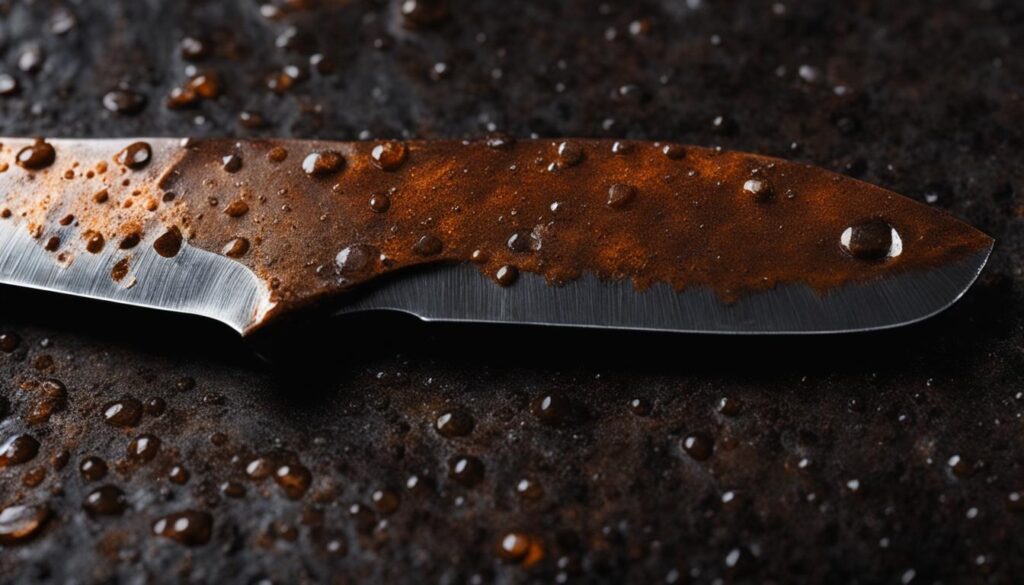
Table: Recommended Lubricants for Different Knife Materials
| Knife Handle Material | Recommended Lubricant |
|---|---|
| Wood | Clinch oil |
| Leather | Coconut oil |
| Other synthetic materials | Choose a suitable lubricant based on manufacturer recommendations |
Keep Your Knife in Good Working Order
Properly maintaining your hunting knife goes beyond just sharpening and cleaning it. Regular inspection and addressing any maintenance issues are essential for keeping your knife in good working order. Here are some tips to help you out:
- Inspect for Damage: Regularly check your knife for any signs of wear and tear, such as loose screws, blade play, or handle damage. Make sure all components are in proper working condition.
- Replace Missing or Damaged Parts: If you notice any missing or damaged parts, such as missing pocket clips or broken blade tips, it’s important to replace them promptly. Reach out to the manufacturer for compatible replacements.
- Adjustments: Simple adjustments like blade centering or handle scale replacement can enhance your knife’s performance. Use a Torx bit driver to make adjustments, but be careful not to over-tighten screws as it can cause damage.
“Regularly inspecting your hunting knife and addressing any maintenance issues will ensure it remains in optimal condition, ready for your next outdoor adventure.”
For more substantial issues or complex repairs, it’s best to reach out to the knife manufacturer’s Customer Service department. They can provide guidance and assistance in resolving the problem. However, before disassembling the knife, be aware of the warranty terms, as it may void the warranty.
Remember, keeping your hunting knife in good working order is crucial for its longevity and reliability. By following these maintenance tips and promptly addressing any issues, you can ensure that your knife is always ready to perform when you need it most.
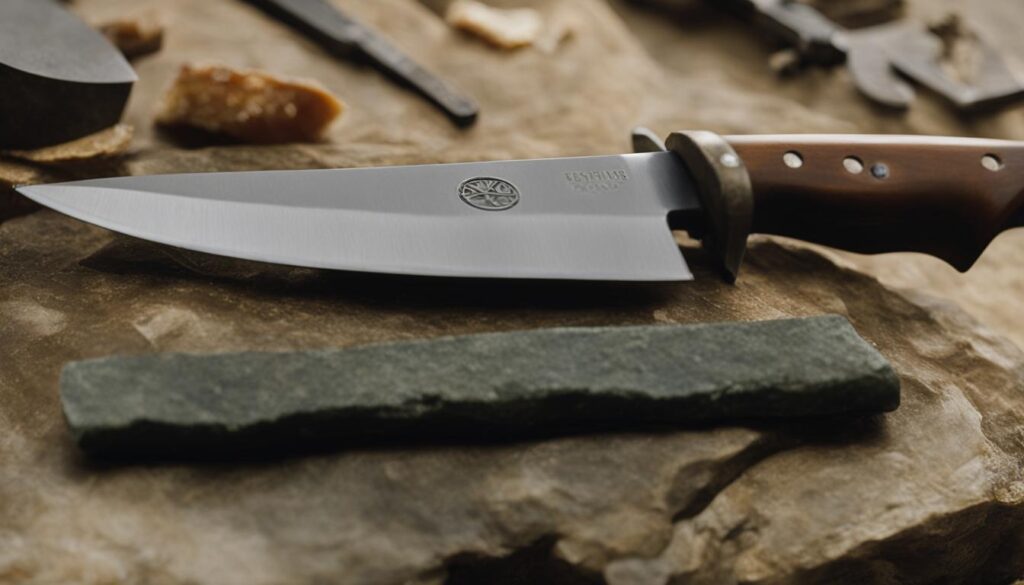

Conclusion
Proper maintenance is crucial for keeping your hunting knife in prime condition. By following these essential tips, you can ensure that your knife stays sharp, clean, dry, well-oiled, and in good working order.
First and foremost, remember to choose the appropriate sharpening methods and angles for your knife. This will help maintain its optimal performance and ensure a safer cutting experience. Regularly touch up the blade using a fine ceramic rod or fine-grit stone to keep it sharp.
Additionally, proper cleaning is essential for the longevity of your hunting knife. Wipe down the blade with a lint-free cloth or paper towel after each use, and use a mild cleaning agent when necessary. Don’t forget to clean inside the handle and around the blade pivot to remove any debris.
To prevent rust formation, it’s crucial to keep your knife dry and well-oiled. Thoroughly dry your knife before storing it, especially if it’s stored in a leather sheath. Apply a small amount of oil to the pivot and other moving parts to keep them lubricated and protected.
Lastly, regularly inspect your knife for any maintenance issues that may arise. Replace any missing or damaged parts, and make simple adjustments using a Torx bit driver. If you have any questions or need assistance, don’t hesitate to reach out to the manufacturer’s Customer Service department.
With these essential tips in mind, you can prolong the lifespan of your hunting knife and ensure that it’s always ready for your outdoor adventures. Take care of your knife, and it will take care of you.
FAQ
How often should I sharpen my hunting knife?
It is recommended to touch up the blade regularly before it becomes too dull. The frequency depends on usage, but a good rule of thumb is to sharpen it after each hunting season or whenever you notice a decrease in performance.
What sharpening method should I use?
Use a fine ceramic rod or fine-grit stone to touch up the blade. Choose the appropriate sharpening method based on the purpose of the blade and the correct edge angle. Consider the recommended edge angles for various types of knives and use different abrasive grits depending on the condition of the blade edge.
How should I clean my hunting knife?
Use a lint-free cloth or paper towel to wipe down the blade and remove debris. For tougher cleaning, use a mild cleaning agent like dish soap and immediately dry the knife. Clean inside the handle and around the blade pivot using a soft-bristle toothbrush, cotton swabs, toothpicks, or compressed air. Rubbing alcohol can be used for stubborn spots, but rinse and dry the knife promptly afterward.
How can I prevent rust on my hunting knife?
Always dry your knife thoroughly before storing it. Apply a small amount of oil to the pivot and other moving parts to keep them lubricated and prevent corrosion. Choose a lubricant suitable for your knife, such as petroleum-based or food-safe options.
What should I do if I have maintenance issues with my hunting knife?
Regularly inspect your knife for any issues that may affect its performance. Replace any missing or damaged parts using compatible replacements from the manufacturer. For simple adjustments, use a Torx bit driver and avoid over-tightening screws. Seek assistance from the manufacturer’s Customer Service department for more substantial issues.
